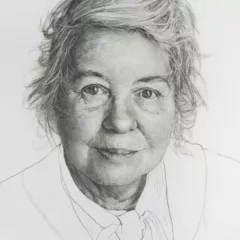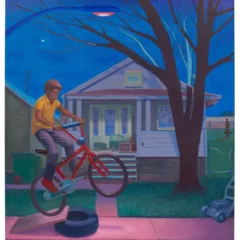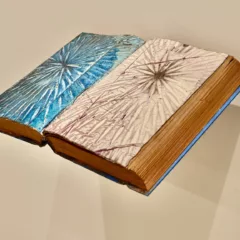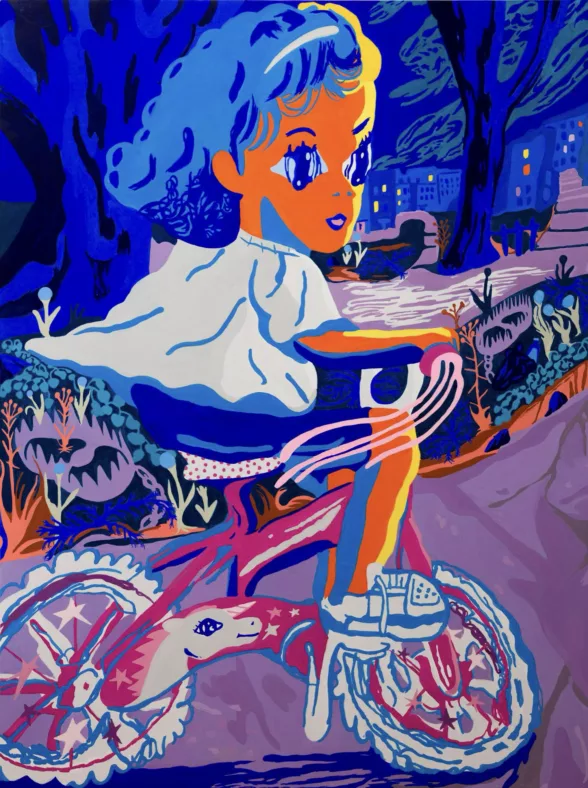
I spent time with Branche Coverdale at his West Philadelphia studio. Branche has an interesting way of speaking. He will often sit in silence until the right thoughts and words appear. He is an observer of his own mind. That sense of Branche as an ‘observer’ of himself and his world came up at first when we discussed his family, but then again, later, especially when we discussed his creative process.
History
Branche Coverdale: I grew up in Yonkers, about 15, 20 minutes from New York City, next to the Hudson River. Then we moved to Rockland County for a couple years and then to back Westchester. I would say I’m a lifetime New Yorker. Yonkers is considered upstate so there’s always that tension… where does upstate begin? It’s close enough to the city, but to some people it’s upstate.
Pete Sparber: I’ve heard a lot of versions of ‘upstate’, but calling Yonkers upstate is pulling the boundary pretty far south.
Branche: Yeah. I lived in the city metro area most of my life. It’s been a big part of my upbringing. That culture of living in cities, concrete, loud noises, people everywhere, the trains, driving around, cars, taxis. Early on my brother and I watched a lot of cartoons and played video games and all of that made an impression on me. It was an introduction to anime and that visual style. It had a big influence on me. A whole generation of people were influenced by it. I think now it’s more common, but where I grew up kids would get bullied for it. It was a very niche thing. I watched a lot of Western animation too… like SpongeBob and Hey Arnold and some classics like Looney Toons. Early on I was interested in trying to figure out how to draw them.
Pete: Any early influences in the family?
Branche: My Dad (Jerome Coverdale) worked in a Hospital. My Mom (April Simmons) was a full-time parent, but she was interested in interior design. I would watch how she would pick out things for the house; how she would design a space. I never met my grandmother (Lillie Simmons), but she had a really creative mind. She knew crafts, like sewing and decorating and cooking.
Pete: That’s your mom’s mom?
Branche: Yeah, my Grandmother. I have two younger twin brothers and an older brother. One twin brother, Joshua, studied film. The other twin, Jalil, entered the fashion business. My older brother Jamal chose a stable job where he works at a major law firm. But I always stuck with art. I always did well in school, but it was that pull that kept calling me to create things, and thinking visually. I took art classes in school with a few mentors who helped me along, but I mostly learned on my own through books and going to museums in the city. In high school, I started to focus on a career. First I wanted to be a production designer for movie sets. I thought that would be a stable career. But I felt like my quirks fit more into something personal, something that I wanted to say. Production design is about supporting a bigger picture. You don’t really have much of a voice. I started pushing more towards things that fulfill my personal narrative. Then I started applying to art schools. I went to RISD for illustration and studied commercial art. When I was studying illustration, there were classes I would take to fulfill the requirements, and then later there were electives. I started getting into printmaking. I did silk screening where I felt I could create things that were authentically me…where I wasn’t trying to do an assignment, but something I could put my personal voice into. It was always finding that balance (between the personal voice and outside requirements). It’s also in illustration, when you’re freelancing, You have a style and you have a voice and the art director is facilitating that voice through their projects.
Coming to Philadelphia

Branche: Back in 2021 my girlfriend (Paige Mehrer) and I wanted a change from Ridgewood (Queens). We visited a couple of cities, Jersey City, Providence and then we came here. I’d never been to Philly, but when I visited I felt like I could live here. Philly has a familiar East Coast environment similar to New York City, but it also has its own culture and energy that make it different and fresh. It’s relatively close to New York City. I could still visit my family. There’s more space and it’s more affordable…a nice place to develop my art. I started doing murals and getting into my personal practice. There are a lot of things creatively I wasn’t doing in New York that I thought I would do there, but here I’m making progress. If you’re constantly stressed out about your financial situation you don’t want to create. I need to find a space where I can afford to live and have peace of mind and the time and space to create.
Branche’s Creative Process
We went on to discuss Branche’s current creative process. To me it seems like Branche has a parallel universe going on in his head, his own personal city. I wanted to talk about that and how it developed.
Branche: I would say everything starts in my sketchbooks. I constantly sketch. Throughout my life, it’s the one thing that allows me to think freely and not have to feel like it has to be for something. In a way it’s a diary where I document and think, the same way people journal their thoughts. So I had my sketchbooks and I just wanted to say more with it. In my sketchbook no one’s gonna see it. Eventually I started painting and seeing how these things could fit into a more thought out, more planned, more focused direction. It was after college and I was doing commercial work, and again there’s that push and pull. I was doing the commercial work for magazines, but I was also doing my more personal stuff in my sketchbooks. So yeah, I moved into these more focused, more planned out elaborate drawings. But sketching is my way of journaling a visual representation of my experiences. It’s meditative. It’s freeing. And It wasn’t until the pandemic when I had enough free time to actually start painting.
Pete: So the pandemic opened time and created this space where you could paint?
Branche Coverdale: Yeah, because before that I was working with (Takashi) Murakami for five years, traveling back and forth to Japan and working in that studio system. During the pandemic, things slowed down and I was able to figure out what I wanted to paint and focus my time into making these worlds that I’ve always thought about.
Time with Takashi Murakami
Pete: So let’s get some specifics about your time after college, and your time with Murakami.
Branche: I graduated in 2014 and started freelancing as an illustrator in New York. There was a job listing for studio assistants, art handlers, that type of thing. I applied to this Japanese company, Kaikai Kiki. I didn’t know it was Murikami’s company. I thought I would just try it. I got a call back for an interview, but didn’t get it the first time. The second time I got the job. I (ended up) working there for five years, traveling from the New York studio to Japan, mostly working on his large scale paintings that are made from hundreds of screens. They buy you a plane ticket. It’s a 12 hour flight. I’m pretty comfortable flying. The studio is in a town outside Tokyo called Miyoshi. It’s an industrial area…it’s like a huge warehouse.
Pete: So it’s a team of people?
Branche: Yeah, I would say 60 people, probably more now. There were (another) 20 or 30 people in the New York studio. So occasionally they would send us to Japan to work on the shows to prep for the big gallery openings.
Pete: I can’t even imagine the logistics. His imagery is so complex…and how that gets translated into screens and how you organize 60 people.
Branche: Yeah. It’s a large operation. There’s different teams and different departments. I was in the paint department, which is mostly just screenprinting and other refinement processes. There’s (also) a computer team. And then he has people who make the 3D works. He has many other businesses that he owns like a little bakery and coffee shop. It’s crazy.
Pete: So how often would you go over there? What was the schedule like?
Branche: At one point I was going there every few months. I would go there for about a month. If you
put it all together it probably adds up to a year and a half (during the five year period).
Pete: During that five year period were you kind of insulated in the studio or did you get some immersion in Japanese culture?
Branche: The whole staff pretty much speaks Japanese. I will say my Japanese is not that great. I’m still trying to learn and practice, but Japanese is just a hard language. I did pick up a few words and phrases. It’s weird because a lot of the words and terminologies I know are studio related, but not (useful for) conversation. But on my days off I would explore Tokyo. As you learn about the culture, you find other types of artistic practice like calligraphy and wood block printing, fashion, movies, TV shows and different artists. I’ve been studying 20th century Japanese artists lately. One of my favorite artists, Keiichi Tanaami, actually died this year. He was a postwar pop artist. His work dealt with what he experienced during World War II. He used vibrant colors and psychedelic imagery.
I wanted to get back into Branche’s creative process and how he explores his ‘parallel universe’.
Pete: How do your paintings evolve?
Branche: To tell you the truth, I don’t really know. I just let my mind drift and start drawing something that interests me. Then as I progress I let my mind go into a more meditative state. That opens me up to exploring different possibilities. For me, drawing is freeing. It feels intuitive. I never plan these things out. Sometimes (I draw upon) different experiences. I’ll remember a TV show or a scene from a movie, and think about it and incorporate it. Or, if I’m outside, taking photographs, I’ll incorporate that. But it’s very fluid and it’s never fully planned out. It’s like if you’re in the passenger seat and you just stare out the window and you’re looking at one thing, and then you go to the next thing.
Pete: When I look at the characters (in your paintings), including the people, the animals, the lampposts, the buildings, all the characters, they feel very human and have their inner life.
Branche: That’s the thing. When I paint, I’m just as curious as the viewer as to what’s going on. Sometimes I like to photograph people, just to capture a moment. I have thousands and thousands of photos. I go through and look for a specific image, and then look for another image, put that together and look for the connective tissue. It’s like a collage. I would see a person or an object on the street and then walk a little more and see something else that catches my eye and then weave them together, and these narratives (emerge). I’m telling a story through images and naturally building the story. That’s exactly the process. Just collecting all these different things that stimulate my mind and putting it all together. I’m kind of like the vessel that just loops it together.
Pete: At some level you’re also stepping back, right?
Branche: Yeah. I try to stay out the way as much as possible. It’s like you go to school, you think about it and you want to do one thing and then life takes you on another path. Life as an art. Even living in Philadelphia was unexpected. 10 years ago, I would have never thought I’d be here. It’s interesting that life, this career, has taken me on this journey with its ups and downs. I’m not saying everything is magical and perfect. There’s a lot of stress. Recently I was teaching at U Arts for a year, and then the school just…
Pete: disappeared,
Branche: Just disappeared. Suddenly, it suddenly disappeared. But I don’t know. It’s just the things I like to do that keep me focused and keep me inspired. Like making murals. It’s commercially oriented in some respects. Before I was doing freelance work for magazines and newspapers, like The New York Times and all that. Illustration gave me a way to conceptualize ideas and how to process things in a more analytical way. So for me that’s a tool I’ve used throughout my career that helps me with painting.
Pete Sparber: Because you’ve got somebody saying ‘this is the thing that we’re trying to illustrate’?
Branche Coverdale: Sometimes you’re interpreting things. I’ll work on an editorial assignment. It’s text-based. So you have to read an article and figure out how to interpret it in a visual way. Not how to summarize it, but how to structure an idea about the article and clue the reader into what the thing is about. So it’s an analytical, conceptual way of thinking. I approach the murals in the same way. This past year I did a mural about food insecurity, so I had to build an image that conceptually deals with that, and also make it this big, painted piece.
How the work is evolving now.

Pete: when I look at some of the work and I see the characters in it and there’s a lot of joy.
Branche: I feel like these more recent works shifted a bit from that. But, yes, there’s a sense of joy and happiness in the work. I want to think of my work as optimistic. I want (the work) to reflect the people who live here. A lot of the figures in my work reflect the Black experience. Living here in America has its hardships. There’s a lot of sadness that comes with living in the city. There’s a lot of displacement, poverty, violence or simply the things you see, the smells, the grittiness of it all. But, it’s also the moments where… this can be a nice place. Or I’ll see a person connecting with their family and they’ll be laughing and experiencing something joyous and simple. Yeah, at times it’s hard to find joy, especially on the East Coast. There’s an attitude to keep things moving. New York is like that. There are times (here) where people are just chilling and hanging out. I try to capture those moments. They’re very fleeting and when you do catch ’em, they’re really, I don’t know… these small moments…they’re really inspiring. They’re moments of connection.
Pete: There was that one painting, “Unicorn,” at Paradigm … the big colorful one of the girl on the bicycle with the bear traps (August 2023, Around the Block exhibition — top image) There was some sense that you were beginning to explore some other kinds of themes.
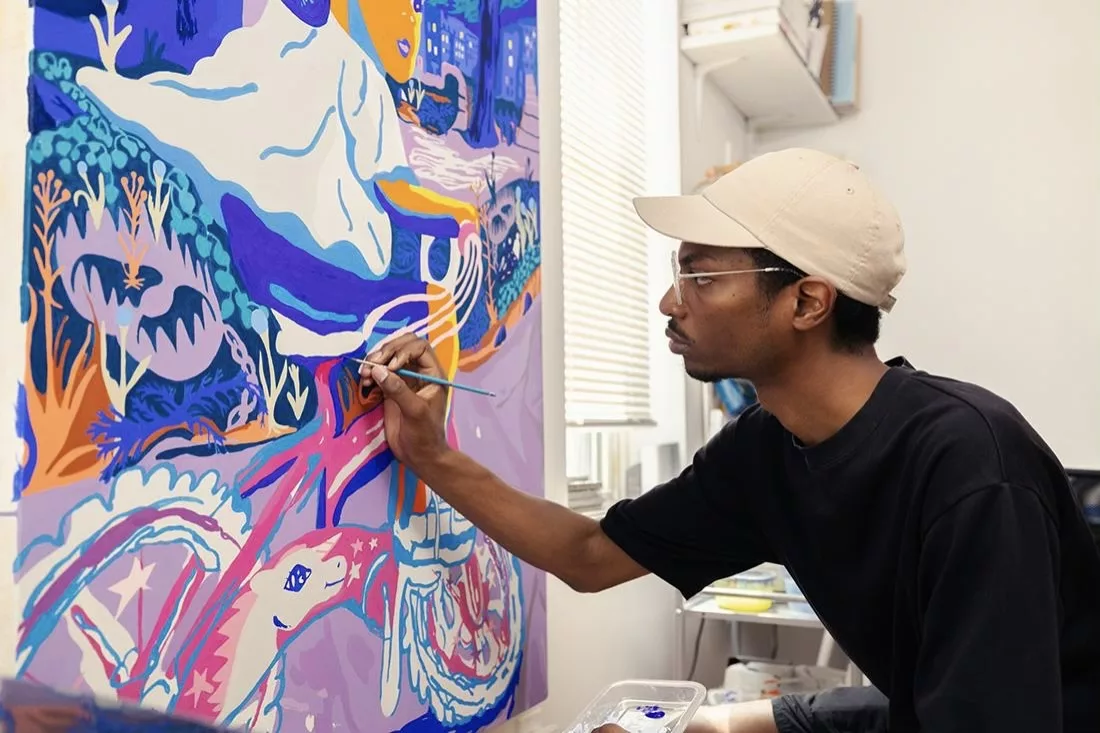
Branche: I don’t want to feel limited to doing one thing. I like to expand my work. I try to force myself to do other things and see where that takes me. The first body of work was very joyous. That’s what I wanted to express. I do want to tap into other emotions. Joy’s always something I’m gonna go back to in my work, but when you’re exploring things like sadness; deeper, heavier stuff, it can also affect you. So in a way I’m not shying away from it, but slowly trying to see how I deal with other subject matter. At some point I would like to tap into those ideas, but you have to arrive there mentally first in order to be able to share that in a creative space. It takes a while to get there. It’s a journey and a progression and I don’t want to do something if I don’t feel ready.
Pete: So what’s happening now with your gallery relationships? I know you’re showing with Paradigm (Encapsulate group show; December 6th – January 5th).
Branche: Paradigm has been a great gallery to work with. It’s allowed me to explore my personal work and give me an opportunity to get into the gallery system. Also, they’re just good people. Yeah. I’m trying to think about connecting with more galleries outside of Philly. Maybe some places in New York, LA, maybe even internationally.
We finished off our talk looking at some of Branche’s newer, smaller work….the ones now on view at Paradigm. There was one piece in particular that attracted me (“Chirp”). In one corner we see someone speaking into a cell phone. In the opposite corner there’s an old fashioned phone booth with the receiver off the hook. The other corners were occupied by tangles of telephone wires. In the center of all this a lone bird on a fence stares out, and behind her, in a black void, dance golden crowns and Mattisse-like petals. The sense of loss, the impossibility of communicating…words spoken but never received, all while the bird is telling us that the real truth is in the blackness. I let him know this new work was wonderful, and that I agreed there should be an audience in New York, LA or Internationally. And if those galleries aren’t interested, well, they’re fools because the work is really something.
Branche’s work can currently be seen at Paradigm Gallery as part of the Encapsulate group show through January 5th. He has worked broadly as an illustrator for clients including the New York Times, Adultswim, Warby Parker, Patagonia and many others. His painting and illustration work, along with his CV, can be found at www.branchecoverdale.com).


